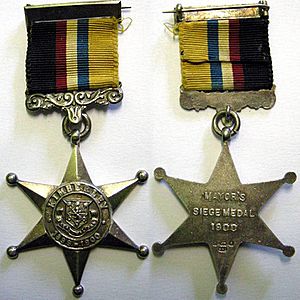Kimberley Star facts for kids
Quick facts for kids Kimberley Star |
|
|---|---|
 |
|
| Country | |
| Type | Campaign medal |
| Eligibility | Defenders of Kimberley |
| Awarded for | the Siege of Kimberley |
| Campaign(s) | Second Boer War |
| Status | Unofficial |
| Statistics | |
| Established | 1900 |
| Related | |
Ribbon bar |
|
The Kimberley Star is a special medal from South Africa's history. It was created in 1900 by the Mayor of Kimberley. This medal was given to everyone who helped defend the town during a tough time.
Kimberley is a town famous for diamond mining. It was under attack for four months in 1899 and 1900. This happened during the Second Boer War. The Kimberley Star is unique because it wasn't an official military medal. It was a private award to thank people for their bravery.
Contents
What Was the Siege of Kimberley?
The Second Boer War started on October 11, 1899. It was a big conflict between the United Kingdom and two Boer Republics. These were the South African Republic and the Orange Free State.
At the start of the war, Boer forces attacked British areas. They surrounded British groups in places like Ladysmith, Mafeking, and Kimberley. The attack on Kimberley began on October 14, 1899. It lasted for four long months. The town was finally freed on February 15, 1900.
Official Medals for the Siege
The British government had its own way to honor those who served. They gave out the Queen's South Africa Medal. This medal had special "clasps" (small bars) that could be added to its ribbon. These clasps showed where and when a person served.
- "DEFENCE OF KIMBERLEY" - This clasp went to all soldiers who were in Kimberley during the siege. This was from October 14, 1899, to February 15, 1900.
- "RELIEF OF KIMBERLEY" - This clasp was for soldiers who helped free Kimberley. This included troops who marched from Klipdrift on February 15, 1900.
Why Was the Kimberley Star Created?
Even though official medals existed, the Mayor of Kimberley, H.A. Oliver, wanted to do more. He wanted to honor not just soldiers, but also regular townspeople. These brave citizens helped defend Kimberley during the siege.
So, in 1900, Mayor Oliver created the Kimberley Star. It was given to all men who helped protect the town. This included members of the British Forces in Kimberley. Groups like the Kimberley Town Guard and the Kimberley Regiment received it. Even the Cape Police and the Diamond Fields Artillery got the medal.
Because it wasn't an official military award, soldiers were not allowed to wear the Kimberley Star on their uniforms.
What Did the Kimberley Star Look Like?
The Kimberley Star was shaped like a six-pointed star. Each point had a small ball on it. It was made of silver and was about 46 millimeters wide. Two of these stars were even made from gold!
The Front (Obverse)
The front of the medal had the Kimberley town shield in the middle. Around the shield, it said "KIMBERLEY" at the top. At the bottom, it showed the years "1899-1900".
The Back (Reverse)
The back of the medal was plain. It had the words "MAYOR'S SIEGE MEDAL 1900" written on it. There was also a small mark to show it was made of silver. Most medals were given without a name on them. But some people had their names engraved on them later.
The Ribbon
The ribbon for the Kimberley Star was 25 millimeters wide. It had five different colored stripes:
- A wide black stripe (8 millimeters)
- A red stripe (3 millimeters)
- A white stripe (3 millimeters)
- A dark blue stripe (3 millimeters)
- A wide yellow stripe (8 millimeters)
Sometimes, the white stripe in the middle was wider than the red and blue ones.
Who Received the Medal?
About 5,000 Kimberley Stars were given out. However, there isn't a complete list of everyone who received one.
Its Special Status
The Kimberley Star is called an "unofficial" medal. This means it wasn't formally approved by the King or Queen at the time. So, it couldn't be worn with military uniforms.
However, some unofficial medals have become very famous and important in South Africa's history. The Kimberley Star is one of four such medals that are considered very significant.
- The Sir Harry Smith's Medal for Gallantry from 1851.
- The Johannesburg Vrijwilliger Corps Medal from 1899.
- The Kimberley Star from 1900.
- The Cape Copper Company Medal for the Defence of O'okiep from 1902.

